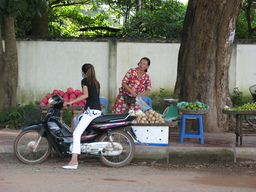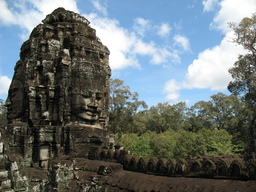 SIEM REAP, Cambodia
SIEM REAP, Cambodia
October 22, 2008
 SIEM REAP, Cambodia
SIEM REAP, Cambodia
October 22, 2008
Siem Reap has been the ideal place to recharge. In spite of how good it was to visit (and to dine with) relatives around Hong Kong, two weeks of non-stop socialization was exhausting.
This city seems to attract both the high- and the low-end. I've seen lots of university-aged western backpackers around town. Restaurants catering to those with tastes in fast-food are everywhere--names include Burgers without Borders and Happy Herb's Pizza. The latter, my guidebook explains, offers marijuana among more standard choices of topping on their pies.
Siem Reap is such a small city. I was initially surprised that the scene of scrappy backpackers hadn't taken over completely and dominated the atmosphere the way it has other destinations--such as Bangkok's Khao San Road and Kathmandu's Thamel. I've hypothesized that the reason Siem Reap has not yet surrendered outright to the dreadlocked, hash-smoking set (as Khao San and Thamel did long ago) is because their presence has been equalized by hordes of middle-aged tour groups. This second set is largely made up of tourists from the East: Koreans, Japanese, and Hong Kongers... playing yin to counteract the young European yang?
Most of these older Asians are the type who travel in groups with pre-paid itineraries and ready-arranged tour buses. They take lots of photos. I've noticed something: the more the photos taken which include the tourist standing in front of whatever historical object visited, the better. Best seem to be shots with the visitor standing next to a sign identifying the site--even if that sign is at some entry-gate far from the actual attraction.
Though I presume that their all-inclusive package doesn't include a slice at Happy Herb's, Siem Reap is clearly the place where the twain shall meet.
There is another faction keeping Siem Reap from falling to the backpackers: the top-notch. The world's wealthy must be coming here too. I've seen lots of luxury and boutique hotels around Siem Reap. Some are chains which even I have heard of (e.g. Le Meridien.) Others seem to be independent outliers (e.g. Hotel de la Paix.) Nice atmosphere; I didn't enquire about rates.
Regardless of just where I might fall in the scheme of things, I've been relaxing, taking advantage of what's on offer at either end. My daily routine involves flaky croissants and coffee: this area was part of French Indochina, after all. I'm splurging slightly on accommodation, staying at a nicer, newer hotel: the Mandalay Inn. I'm sure room rates there must be some single-digit fraction of those at de la Paix. Reversing the equation, what I'm paying must also be several-fold the rates at the backpacker dormitories. I figure staying at a place like the Mandalay Inn is good value and just what I need right now: a clean, private, well-serviced space of my own. It's been the right decision to splash out a little this week.
 Fruit Vendor, Siem Reap |
I made the decision to visit the Temples of Angkor nearly two years ago. At that time, I was on a different trip. That was a great journey. I was cycling from temple to temple around Bagan--in Burma--over a few days. I had never imagined--let alone seen--anything like Bagan: elaborate, ancient Buddhist temples peppering the landscape in all directions. I remember thinking that if my hometown in the U.S. had just one of those temples it would be the landmark and pride of the city. Few sites in the U.S. could have historical or architectural signifcance approaching that of the temples of Bagan. And the area around Bagan had hundreds of temples scattered about. I was dazzled.
However, a few fellow foreign travelers I met on that trip likened Bagan to Angkor--only not as impressive.
"Yeah, these temples are nice. Same idea as Angkor Wat, though. There are more here and they're closer together... but none of them is as ornate as any of the temples around Cambodia," I recall a traveler with a British accent telling me on a bus journey out of Bagan.
I decided I'd have to compare some day.
There were thundershowers over the first four days I stayed in Siem Reap. My plan had been--as with my trip around the temples of Bagan--to rent a bicycle and visit as many as I could over a three-day block. The Angkor temples are spread well outside of the city. Visiting requires buying a pricey admission ticket which has to be used on a string of consecutive days. I decided to stay in, waiting for the weather to clear up.
So, for my first four days in the area I saw no temples. Instead, when not with coffee and croissants, I got to know Cambodian food. Amoc is a dish which became my instant favorite; the closest thing I can liken it to is a curry. There are fruits here I never see other places: mangosteen, rambutan. Stalls along the street turn these fruits into delicious, icy milkshakes. (I've discovered the secret to making a fruit shake with a nice, thick consistency: throw a banana into the blender along with everything else.)
 Bayon Temple |
They were amazing. Ordinarily, I'd like to offer some historical background with specific details: "12th century, Khmer Kingdom, etc...". I could crib some of that from descriptions I read at the temples or something I've read in my guidebook. However, there's probably nothing original I could say about the temples. My descriptions would use simple adjectives. These temples are the type of thing you can't believe exists. How could people construct something like this today--let alone a thousand years ago?
So, I'll leave it at "amazing" and won't try to describe the details. I'm not the one who can add anything new about Angkor Wat.